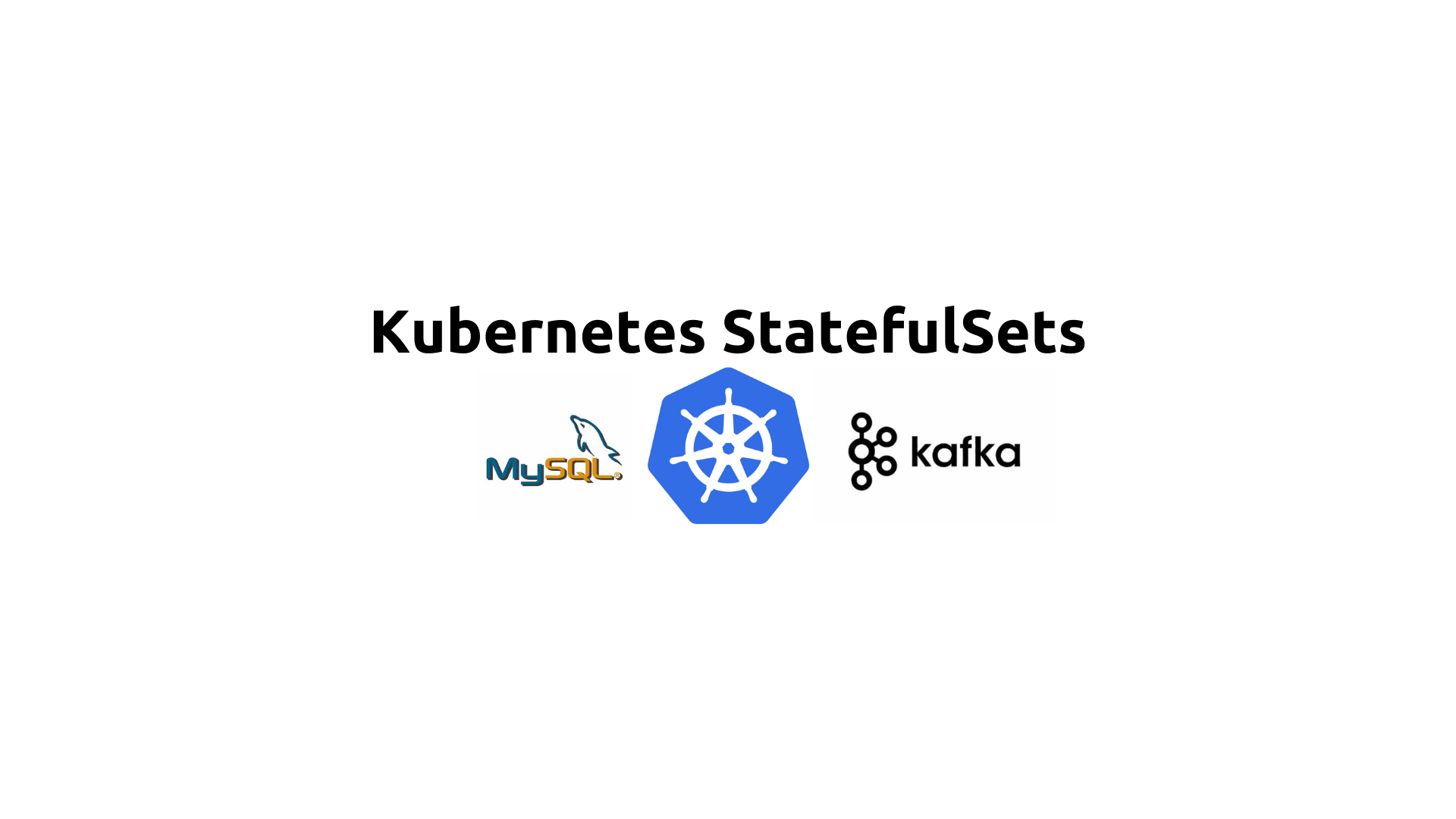Kubernetes StatefulSets
 Saurabh Adhau
Saurabh Adhau
Introduction
Kubernetes provides various mechanisms to manage and orchestrate containerized applications, with StatefulSets being a crucial component for applications requiring stable, unique network identifiers and persistent storage. This article explores what StatefulSets are, their advantages, suitable scenarios, practical examples, and how to scale StatefulSets effectively.
What are StatefulSets?
StatefulSets are a Kubernetes resource designed to manage stateful applications. Unlike Deployments, which are intended for stateless applications, StatefulSets provide guarantees about the ordering and uniqueness of pods. Each pod in a StatefulSet has a stable, unique network identity that persists across rescheduling.
Key Features of StatefulSets
Stable Network Identity: Each pod gets a unique, stable hostname.
Stable Storage: Each pod is associated with a persistent volume, retaining data across rescheduling.
Ordered Deployment and Scaling: Pods are created, updated, and deleted in a specific order.
Ordered, Graceful Rolling Updates: Pods are updated in sequence, ensuring application stability during upgrades.
Pros of Using StatefulSets
Data Persistence: Ensures that data stored by the application is not lost during pod rescheduling.
Stable Network Identity: Each pod retains the same hostname, facilitating stable network identities.
Ordered Operations: Guarantees the order of pod creation, update, and deletion, which is critical for applications like databases.
Easy Scaling: Simplifies scaling stateful applications while maintaining data integrity.
Scenarios for Using StatefulSets
StatefulSets are ideal for applications that require one or more of the following:
Persistent Storage: Applications like databases (MySQL, PostgreSQL, MongoDB) that need data persistence.
Stable Network Identities: Services requiring consistent network identities, such as Zookeeper, Kafka, or Redis.
Ordered Deployment: Applications needing ordered startup and shutdown processes.
Practical Examples of StatefulSets
Example 1: Deploying a Stateful MySQL Cluster
Step 1: Create a Headless Service
A headless service is required to manage the network identities of the pods in the StatefulSet.
apiVersion: v1
kind: Service
metadata:
name: mysql
spec:
ports:
- port: 3306
clusterIP: None
selector:
app: mysql
Create the service using:
kubectl apply -f mysql-service.yaml
Step 2: Create a StatefulSet
Define the StatefulSet to deploy a MySQL cluster.
apiVersion: apps/v1
kind: StatefulSet
metadata:
name: mysql
spec:
serviceName: "mysql"
replicas: 3
selector:
matchLabels:
app: mysql
template:
metadata:
labels:
app: mysql
spec:
containers:
- name: mysql
image: mysql:5.7
ports:
- containerPort: 3306
env:
- name: MYSQL_ROOT_PASSWORD
value: "rootpassword"
volumeMounts:
- name: mysql-persistent-storage
mountPath: /var/lib/mysql
volumeClaimTemplates:
- metadata:
name: mysql-persistent-storage
spec:
accessModes: [ "ReadWriteOnce" ]
resources:
requests:
storage: 1Gi
Apply the StatefulSet configuration using:
kubectl apply -f mysql-statefulset.yaml
Example 2: Deploying a Kafka Cluster
Step 1: Create a Headless Service
apiVersion: v1
kind: Service
metadata:
name: kafka
spec:
ports:
- port: 9092
clusterIP: None
selector:
app: kafka
Create the service using:
kubectl apply -f kafka-service.yaml
Step 2: Create a StatefulSet
apiVersion: apps/v1
kind: StatefulSet
metadata:
name: kafka
spec:
serviceName: "kafka"
replicas: 3
selector:
matchLabels:
app: kafka
template:
metadata:
labels:
app: kafka
spec:
containers:
- name: kafka
image: wurstmeister/kafka:2.13-2.6.0
ports:
- containerPort: 9092
env:
- name: KAFKA_BROKER_ID
valueFrom:
fieldRef:
fieldPath: metadata.name
- name: KAFKA_ZOOKEEPER_CONNECT
value: zookeeper:2181
volumeMounts:
- name: kafka-persistent-storage
mountPath: /kafka
volumeClaimTemplates:
- metadata:
name: kafka-persistent-storage
spec:
accessModes: [ "ReadWriteOnce" ]
resources:
requests:
storage: 1Gi
Apply the StatefulSet configuration using:
kubectl apply -f kafka-statefulset.yaml
Scaling StatefulSets
Scaling StatefulSets is essential for managing workload changes, improving application performance, and maintaining availability. Kubernetes allows you to scale StatefulSets easily while preserving the guarantees of stable network identities and persistent storage.
Scaling Up
To scale up a StatefulSet, you simply increase the number of replicas. For example, to scale the MySQL StatefulSet from 3 to 5 replicas, you can use the following command:
kubectl scale statefulset mysql --replicas=5
This command increases the number of MySQL pods, creating additional pods with unique identities and stable storage.
Scaling Down
To scale down a StatefulSet, decrease the number of replicas. For example, to scale the Kafka StatefulSet from 3 to 2 replicas:
kubectl scale statefulset kafka --replicas=2
When scaling down, Kubernetes deletes pods in reverse order, ensuring data integrity and application stability.
Autoscaling StatefulSets
While Kubernetes supports Horizontal Pod Autoscaling (HPA) for Deployments and ReplicaSets, it does not natively support HPA for StatefulSets. However, you can achieve similar functionality using custom metrics and the Kubernetes metrics server.
Step 1: Install Metrics Server
Ensure the metrics server is installed in your cluster:
kubectl apply -f https://github.com/kubernetes-sigs/metrics-server/releases/latest/download/components.yaml
Step 2: Configure Custom Metrics
Create a custom metrics-based autoscaler using the Kubernetes API and tools like Prometheus. This setup involves configuring Prometheus to collect metrics and creating an autoscaler that scales the StatefulSet based on these metrics.
Example: Scaling MySQL Based on CPU Usage
apiVersion: autoscaling/v2beta2
kind: HorizontalPodAutoscaler
metadata:
name: mysql-autoscaler
spec:
scaleTargetRef:
apiVersion: apps/v1
kind: StatefulSet
name: mysql
minReplicas: 3
maxReplicas: 10
metrics:
- type: Resource
resource:
name: cpu
target:
type: Utilization
averageUtilization: 50
Apply the HPA configuration:
kubectl apply -f mysql-autoscaler.yaml
Conclusion
StatefulSets in Kubernetes provide a robust solution for managing stateful applications that require stable network identities and persistent storage. They are ideal for deploying databases, messaging systems, and other stateful applications. By leveraging the ordered deployment and scaling features, you can ensure the reliability and stability of your stateful services within a Kubernetes cluster. The practical examples provided demonstrate how to deploy and scale MySQL and Kafka clusters using StatefulSets, highlighting their ease of use and effectiveness in managing stateful workloads.
Subscribe to my newsletter
Read articles from Saurabh Adhau directly inside your inbox. Subscribe to the newsletter, and don't miss out.
Written by

Saurabh Adhau
Saurabh Adhau
As a DevOps Engineer, I thrive in the cloud and command a vast arsenal of tools and technologies: ☁️ AWS and Azure Cloud: Where the sky is the limit, I ensure applications soar. 🔨 DevOps Toolbelt: Git, GitHub, GitLab – I master them all for smooth development workflows. 🧱 Infrastructure as Code: Terraform and Ansible sculpt infrastructure like a masterpiece. 🐳 Containerization: With Docker, I package applications for effortless deployment. 🚀 Orchestration: Kubernetes conducts my application symphonies. 🌐 Web Servers: Nginx and Apache, my trusted gatekeepers of the web.